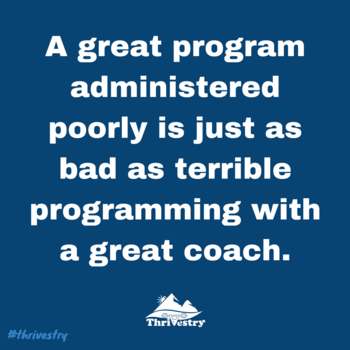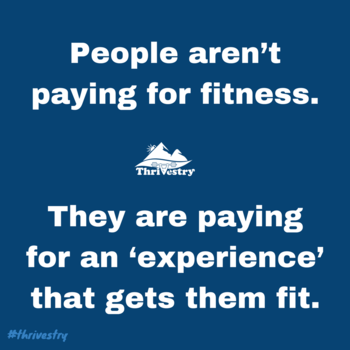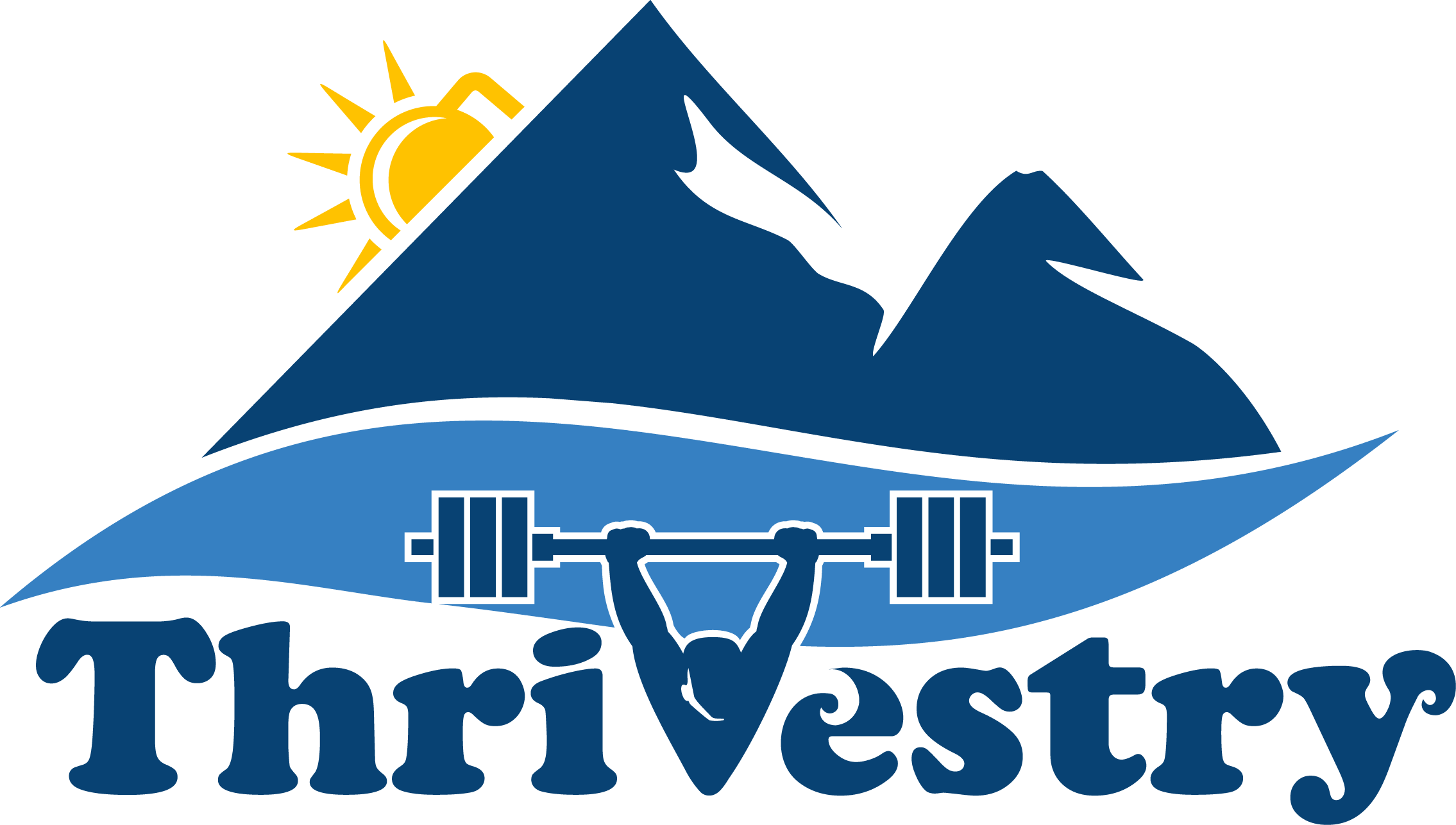What Programming Can and Can't Do for Class Experience Part 1

As more and more gyms start to realize that good programming takes time, we are starting to see many come around to the idea of hiring experts to provide the best results while saving the time and the headache of always worrying about the programming.
That said, I haven’t seen enough discussion on where the lines between good programming and good coaching cross, and what each can and can’t do.
To put it simply:
A great program administered poorly is just as bad as terrible programming with a great coach.
I believe that most gyms have shades of gray here. Maybe their programming could be better (especially when the person doing the programming is pressed for time, isn’t the best on the computer, etc.), but their coaching is top notch. The coaches come together weekly to talk about the programming and the plan for the rest of the class time. They really know their members and how to scale properly. They can ‘read’ the workouts and make sure the stimulus is the same across all of the classes each day. They know how to step into people’s workouts, mid-stream, and make corrections and adaptations when needed.
Above all, they INSTRUCT and LEAD for the entire hour.
In this scenario, people will get okay results and have a decent experience at the gym. Injuries will not be too frequent. People will probably stick around a while, but they will plateau and will only stay for years out of habit and because they love their coach.
The problem here is that great coaches aren’t common. They take years to develop. Even in the best gyms, there is some significant difference between the best coach and the worst coach.
On the other end of the spectrum, there are gyms with really dialed in programming where they are buying it from an expert or an educated and experienced person is spending 4-5+ hours a week planning, writing, posting (or about 45 min per day on average). But the coaches aren’t delivering it well.
The coach is starting the class late. They are on their phone or eating. They chop it up with their friends, but hardly talk to the other members. Clients must figure out their own warm ups and scaling. Once the music is up, all they do is cheer people on and yell at them to go harder. They workout with the class all the time. They do not give feedback to people, or explain the ‘why’ behind the programming or the movements we are doing.
Really intelligent programming will still get decent results in this case, but clients will not be able to maximize their time invested. We will still see some injuries and people may stick around a while. But eventually, they will gravitate to training on their own, possibly quitting. What is the point of going to ‘classes’ when they aren’t getting any coaching?

The problem here is that people aren’t paying for fitness. They are paying for an ‘experience’ that gets them fit. If their experience each hour they come to the gym isn’t fulfilling, they will quit. Many people will not stick around long enough to experience the results, no matter how good the programming is.
The Magic
The magic happens when the programming is on point, AND the coaches are dialed in. There is a multiplication that happens. Great programming and great coaching combined means that people will stick around for decades, without any real disruptions to their progress. They will achieve their goals faster, and they will do things they never thought possible.
Every gym should strive to move both coaching and programming to the best levels possible. Below are some ideas that can make the experience of coming to your gym the best hour of your member’s day.
Programmers should (at a minimum):
- Have an annual calendar with themes to follow (a macro view)
- Use smaller (6-12) week focuses on skills or progressions
- Make sure that there aren’t any movement ‘blind spots’ or overuse issues
- Make sure that movements aren’t being repeated on the same days week to week (having squats every Monday means that people who can’t come on Monday are missing out!)
- Understand that people have lives, creating complicated programs that don’t work if you miss a few days aren’t very functional for ‘regular’ people.
- The workouts are created for the average people. Program for the ‘rest’, and scale up for the ‘best’.
- Have adequate guidance on each workout for proper scaling.
- Write out detailed instructions so the stimulus is consistent class to class.
- Have a scaling guide, so coaches and members can be smarter with their progression selections.
- Repeat workouts often enough so that people can see progress, and not so often they become monotonous.
- Use workouts that aren’t just ‘For time’ and ‘AMRAP’, to keep things interesting.
- Create workouts that aren’t too hard to fit into your square footage, and don’t need too much equipment, or have so many movements the coach can’t adequately ‘teach’ each thing.
- Spend time each week educating coaches so they can adequately explain the concepts to the members.
- Take the time to actually plan/program context, mobility, skill work, lifting progressions, and cash outs, instead of leaving it up to the members and the coaches to make it up as they go.
- Make sure the daily volume isn’t too much to fit into the hour so the classes don’t feel rushed.
I could go on, but this list is supposed to be the minimum!
To improve coaching:
- The coaches come together weekly to talk about the programming and the plan for the rest of the class time.
- Coaches really know the members and how to scale properly (and have ample ‘tools’ in the toolbox to attack problems from many angles).
- The coaches know how to ‘read’ the workouts and make sure the stimulus is the same across all of the classes each day (and they ask questions when they don’t know).
- The coaches are always stepping into people’s training to give corrections and feedback.
- The coaches make sure that the hour is packed with good instruction, while being a bit entertaining, building relationships, and not making it feel too ‘rushed’.
- The coaches have enough education to teach movement well. They have learned from multiple sources and when they encounter a new issue with a client, they seek out answers so they will be prepared the next time it shows up.
- They give their full attention to the class, and they use everyone’s name at least twice.
- The coaches make sure that every person got some coaching and is leaving the gym with an understanding of what they need to do to improve.
- The coaches ‘look the part’. They dress like a professional (they wear workout clothes), and they take care of themselves (and/or can do the stuff they are teaching).
- They make sure that the classes have some fun to them. They do fun games, keep the workouts interesting (making people combine scores to compare to other ‘teams’, they stagger people so people don’t know who will finish first, they use creative substitutions), they ask good questions so people bond, etc.
Things to Avoid
The worst gyms that I have seen come and go over the last 12 years have more than a few things in common:
- They make the programming up as they go.
- They make/choose workouts that ‘look cool’, ‘look fun’, or worse, ‘look brutal’.
- They treat their members like ‘lab rats’ and experiment on them, rather than follow proven systems.
- They don’t track the progress of their clients, the frequency of injuries, and they don’t get feedback from the coaches on how the lesson plans are working in the hour.
- Their coaches are ‘managers’ and not ‘leaders’. They just make sure everyone starts the WOD on time, that the music is good, and that everyone puts their equipment away.
- Their coaches are focused more on their own training, and not the progress of the members.
- Their coaches cannot ‘relate’ to regular people who don’t live and breathe the gym life / CrossFit.
- The coaches look down on people and even laugh behind their backs when people struggle.
- The coaches ‘hook up’ with clients and each other frequently.
- The coaches stick to their cliques, and they don’t make the environment inclusive.
Next Steps
Print this list out (Class experience checklist programming and coaching.pdf) and check off what you are currently doing. Work on adding 1-2 from each list every week or so from the ‘good’ lists, and eliminating - as fast as possible - anything from the ‘bad’ list. Check the list often so that you keep making progress and to ensure you aren’t back sliding.
The gym business is a competitive market. The only way to distinguish yourself is to constantly work on your own systems and staff. You also owe it to you members. They are entrusting that you are doing your best to make their lives better. If you don’t have the time or the energy to give your best, find solutions (like outsourcing / training / hiring) that will guarantee a great experience.
In part 2, I’ll compare two versions of the same workout and give examples on how the programming can improve the client experience and make the coaches job easier and better!
Thrive on.
-jj

0 comments
Leave a comment